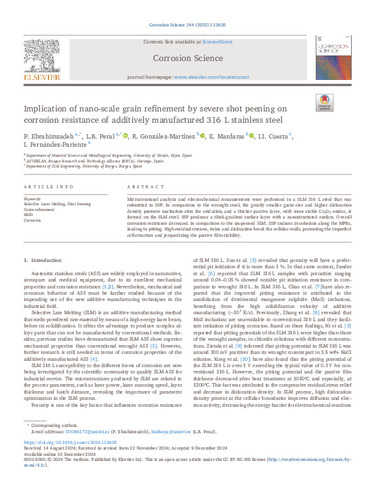Implication of nano-scale grain refinement by severe shot peening on corrosion resistance of additively manufactured 316 L stainless steel
Autor(es) y otros:
Fecha de publicación:
Versión del editor:
Citación:
Resumen:
Microstructural analysis and electrochemical measurements were performed in a SLM 316 L steel that was submitted to SSP. In comparison to the wrought steel, the greatly smaller grain size and higher dislocation density promote nucleation sites for oxidation, and a thicker passive layer, with more stable Cr2O3 oxides, is formed on the SLM steel. SSP produces a thick-gradient surface layer with a nanostructured surface. Overall corrosion resistance decreased in comparison to the un-peened SLM. SSP induces decohesion along the MPBs, leading to pitting. High-residual stresses, twins and dislocation break the cellular-walls, promoting the imperfect cell-structure and jeopardizing the passive film stability.
Microstructural analysis and electrochemical measurements were performed in a SLM 316 L steel that was submitted to SSP. In comparison to the wrought steel, the greatly smaller grain size and higher dislocation density promote nucleation sites for oxidation, and a thicker passive layer, with more stable Cr2O3 oxides, is formed on the SLM steel. SSP produces a thick-gradient surface layer with a nanostructured surface. Overall corrosion resistance decreased in comparison to the un-peened SLM. SSP induces decohesion along the MPBs, leading to pitting. High-residual stresses, twins and dislocation break the cellular-walls, promoting the imperfect cell-structure and jeopardizing the passive film stability.
ISSN:
Notas Locales:
OA ATUO24
Patrocinado por:
Spanish Government [TED2021-130306B-100]; MICINN [PID2021-124768OB-C21, TED2021-130413B-I00]; Next Generation EU funds
Colecciones
- Artículos [37549]
- Ciencias de los Materiales e Ingeniería Metalúrgica [156]
Ficheros en el ítem




